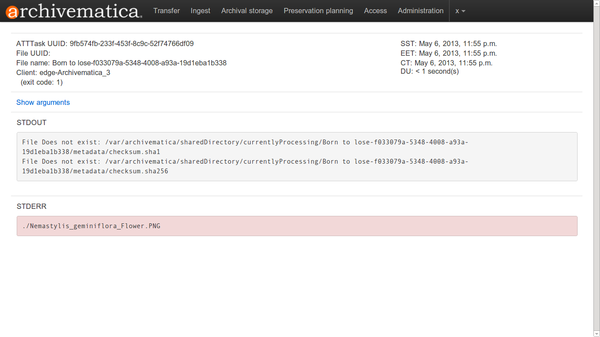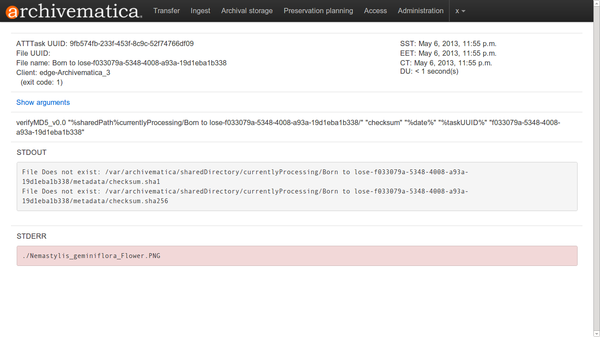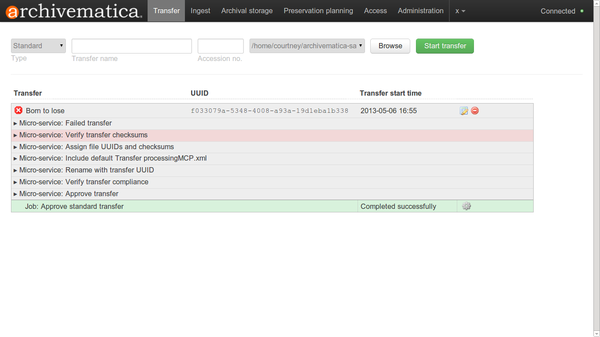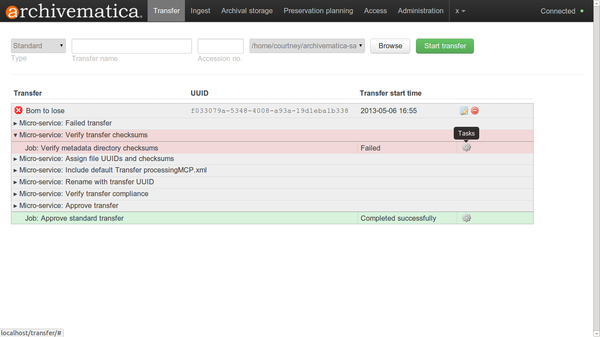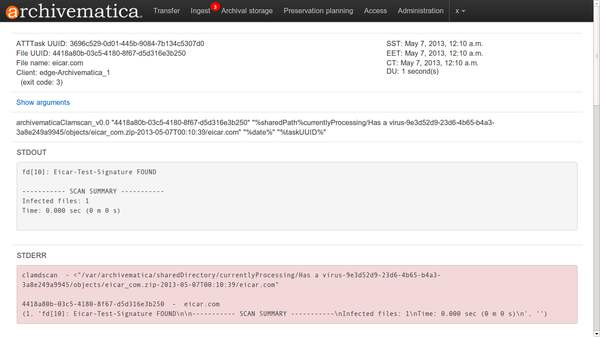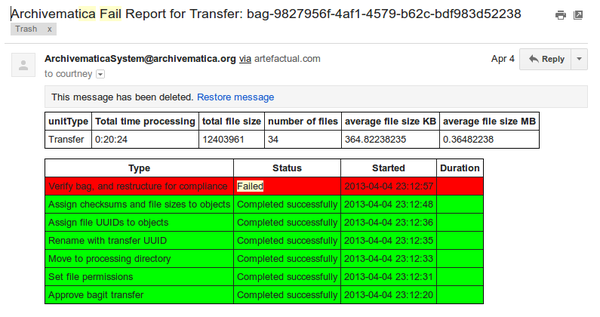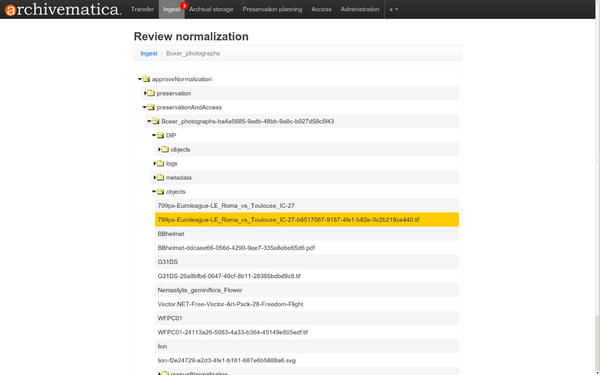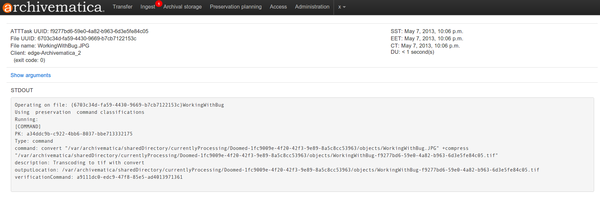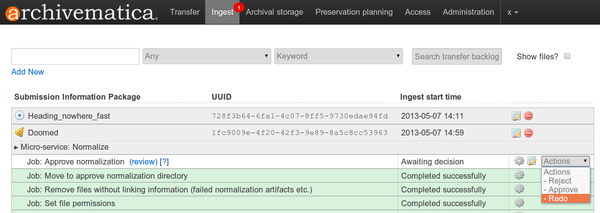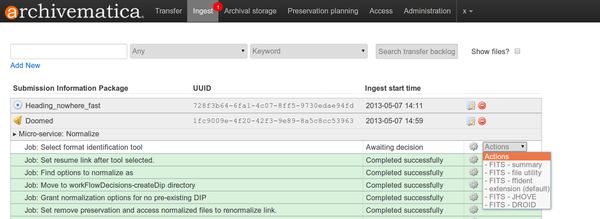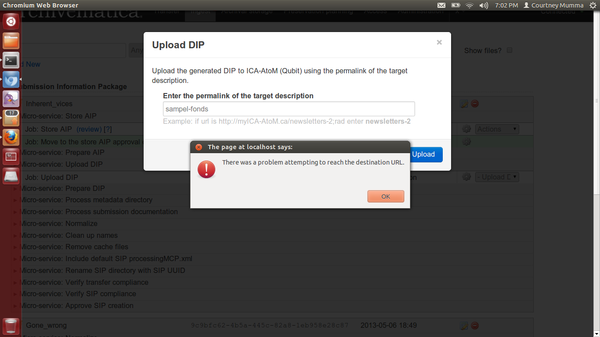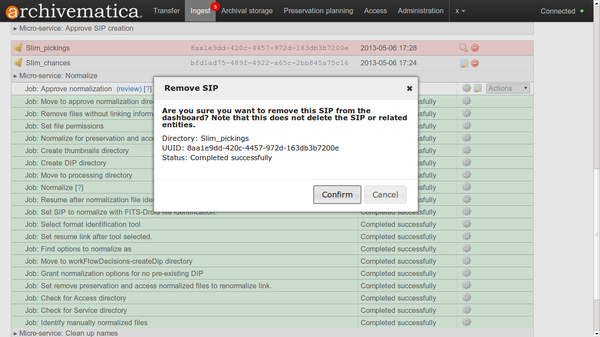Difference between revisions of "UM error handling"
| (11 intermediate revisions by the same user not shown) | |||
| Line 1: | Line 1: | ||
[[Main Page]] > [[Documentation]] > [[User Manual|User manual]] > [[User manual 0.10]] > Error handling | [[Main Page]] > [[Documentation]] > [[User Manual|User manual]] > [[User manual 0.10]] > Error handling | ||
| − | |||
== General description == | == General description == | ||
| Line 23: | Line 22: | ||
#Click the tasks icon (the gear icon on the right-hand side) to open up an error report ('''figure 3'''). These reports are generally standard and predictable for certain types of errors and are useful for trouble-shooting. Note that the failed file(s) will always appear at the top of the report.[[Image:ErrorRptFailVirusScan-10.png|600px|right|thumb|'''Figure 3''' An error report showing that a virus has been found in a file]] | #Click the tasks icon (the gear icon on the right-hand side) to open up an error report ('''figure 3'''). These reports are generally standard and predictable for certain types of errors and are useful for trouble-shooting. Note that the failed file(s) will always appear at the top of the report.[[Image:ErrorRptFailVirusScan-10.png|600px|right|thumb|'''Figure 3''' An error report showing that a virus has been found in a file]] | ||
| + | </div> | ||
| + | |||
| + | <div class="clearfix"> | ||
| + | |||
| + | </div> | ||
| + | == Email error report == | ||
| + | #If the user has an email address associated with their user account, the dashboard can email a failure report ('''figure 4'''). | ||
| + | [[Image:EmailFail-10.png|600px|right|thumb|'''Figure 4''' An emailed failure report showing an error at Verify bag micro-service]] | ||
</div> | </div> | ||
| Line 30: | Line 37: | ||
== Normalization errors == | == Normalization errors == | ||
| − | #The dashboard will report normalization errors when: | + | #The dashboard will report normalization errors when: |
#*Normalization is attempted but fails | #*Normalization is attempted but fails | ||
#*No normalization is attempted and the file is not in a recognized preservation or access format | #*No normalization is attempted and the file is not in a recognized preservation or access format | ||
| − | #When normalization fails, the SIP continues processing until it reaches the normalization approval step. At this point, the user can click on the report icon next to the Actions drop-down menu to see a summary report of the normalization ('''figure | + | #When normalization fails, the SIP continues processing until it reaches the normalization approval step. At this point, the user can: |
| − | #The report | + | #*click on the report icon next to the Actions drop-down menu to see a summary report ('''figure 5''') of the normalization and/or |
| − | #The user may choose to continue processing the SIP despite any normalization errors. | + | #*click Review in parentheses next to the micro-service to view the normalization results in a directory structure in a new browser tab ('''figure 6'''). |
| + | #The report ('''figure 5''') shows what has been normalized, what is already in an acceptable preservation and access format, and what has failed normalization or is not in a recognized preservation or access format. If normalization has failed, you can click on "yes" to see a task report of the error in a new tab ('''figure 7'''). | ||
| + | #The review ('''figure 6''') allows the user to either open the objects in the browser when there is an appropriate plug-in or download the objects and open them using a local application. | ||
| + | #The user may choose to continue processing the SIP despite any normalization errors. | ||
| + | #The user may choose to redo normalization ('''figure 8'''), as well. For instance, if the user chose to normalize based on FITS-JHOVE results and experienced failures, the user may wish to redo normalization and choose to normalize based on FITS-DROID results instead ('''figure 9'''). | ||
| + | [[Image:NormReporterror-10.png|600px|right|thumb|'''Figure 5''' Normalization report showing failed normalization attempts]] | ||
| + | [[Image:RvrNorm-10.png|600px|right|thumb|'''Figure 6''' Review normalization results in a new tab]] | ||
| + | [[Image:Normreporterrortask-10.png|600px|right|thumb|'''Figure 7''' Task output for failed normalization job]] | ||
| + | [[Image:Normdropdown-10.png|600px|right|thumb|'''Figure 8''' Redo normalization option in drop-down menu of Approve normalization job]] | ||
| + | [[Image:SelectFormatIdTool-10.png|600px|right|thumb|'''Figure 9''' Choose format identification tool from which to base normalization actions]] | ||
</div> | </div> | ||
| Line 44: | Line 60: | ||
== DIP upload error == | == DIP upload error == | ||
| − | |||
| − | |||
| + | # Archivematica will allow the user to continue to attempt to upload the DIP if a mistake was made entering the permalink ('''figure 10'''). | ||
| + | [[Image:DIPUploadTryAgain-10.png|600px|right|thumb|'''Figure 10''' Warning that permalink was incorrect, allows user to retry upload DIP]] | ||
</div> | </div> | ||
| Line 55: | Line 71: | ||
== Other common error behaviours == | == Other common error behaviours == | ||
| − | |||
#Verify metadata directory checksums: if the checksums in the ''metadata'' directory cannot be verified (i.e. if a file is missing or corrupted) the micro-service will fail and the transfer will be moved in the ''failed'' directory. | #Verify metadata directory checksums: if the checksums in the ''metadata'' directory cannot be verified (i.e. if a file is missing or corrupted) the micro-service will fail and the transfer will be moved in the ''failed'' directory. | ||
#Scan for viruses: if a virus is found the micro-service will fail and the transfer will be moved in the ''failed'' directory. | #Scan for viruses: if a virus is found the micro-service will fail and the transfer will be moved in the ''failed'' directory. | ||
| Line 70: | Line 85: | ||
== Rejecting a transfer or SIP == | == Rejecting a transfer or SIP == | ||
| − | At any of the workflow approval points the user can choose to reject a transfer, SIP, AIP or DIP (depending on where the information object is in the workflow). This will move the transfer or SIP to the ''Rejected'' directory (accessible from the | + | At any of the workflow approval points the user can choose to reject a transfer, SIP, AIP or DIP (depending on where the information object is in the workflow). This will move the transfer or SIP to the ''Rejected'' directory (accessible from the file browser) and will stop all processing on it. The transfer or SIP will still be listed in the dashboard, however. See '''Removing a transfer or SIP from the dashboard''', below, to remove it from the dashboard. |
</div> | </div> | ||
| Line 80: | Line 95: | ||
== Removing a transfer or SIP from the dashboard == | == Removing a transfer or SIP from the dashboard == | ||
| − | To remove a transfer or SIP from the dashboard, click on the red "Remove" icon in the dashboard as shown in '''figure | + | To remove a transfer or SIP from the dashboard, click on the red "Remove" icon in the dashboard as shown in '''figure 11'''. [[Image:RemoveSIPDash-10.png|600px|right|thumb|'''Figure 11''' Click on the red ''Remove'' icon to remove a transfer or SIP from the dashboard, then click "Confirm"]] |
Latest revision as of 17:06, 7 May 2013
Main Page > Documentation > User manual > User manual 0.10 > Error handling
General description[edit]
Archivematica anticipates that a number of different types of errors can occur during processing. Some of them will result in processing being halted and the transfer or SIP being moved to the failed directory in the file browser. For others, processing can continue: for example, a normalization failure is reported and the user is given the opportunity to continue processing the SIP.
If you don't find an answer here or elsewhere in the user manual, please try searching the public user forum. Someone may have had the same problem before and been offered a solution. If you do not find the answer there, feel free to ask us a question. The best questions to the list include as much information as possible about the error. This means offering us information about the system(s) you're using, the content of your transfer(s), and copying the task information (click on the cog icon on the same line as the micro-service job where the error occurred) and show arguments data output. See task information and show arguments data for the same error, below.
Dashboard error reporting[edit]
- When a micro-service fails or encounters an error, the micro-service background turns from green to pink and a "failed" icon appears next to the transfer or SIP name (figure 1). Clicking on the micro-service will expand to show the specific job that contains an error (figure 2).
- Note that the transfer shown in figure 1 has been moved to the failed directory and processing has been halted.
- Click the tasks icon (the gear icon on the right-hand side) to open up an error report (figure 3). These reports are generally standard and predictable for certain types of errors and are useful for trouble-shooting. Note that the failed file(s) will always appear at the top of the report.
Email error report[edit]
- If the user has an email address associated with their user account, the dashboard can email a failure report (figure 4).
Normalization errors[edit]
- The dashboard will report normalization errors when:
- Normalization is attempted but fails
- No normalization is attempted and the file is not in a recognized preservation or access format
- When normalization fails, the SIP continues processing until it reaches the normalization approval step. At this point, the user can:
- click on the report icon next to the Actions drop-down menu to see a summary report (figure 5) of the normalization and/or
- click Review in parentheses next to the micro-service to view the normalization results in a directory structure in a new browser tab (figure 6).
- The report (figure 5) shows what has been normalized, what is already in an acceptable preservation and access format, and what has failed normalization or is not in a recognized preservation or access format. If normalization has failed, you can click on "yes" to see a task report of the error in a new tab (figure 7).
- The review (figure 6) allows the user to either open the objects in the browser when there is an appropriate plug-in or download the objects and open them using a local application.
- The user may choose to continue processing the SIP despite any normalization errors.
- The user may choose to redo normalization (figure 8), as well. For instance, if the user chose to normalize based on FITS-JHOVE results and experienced failures, the user may wish to redo normalization and choose to normalize based on FITS-DROID results instead (figure 9).
DIP upload error[edit]
- Archivematica will allow the user to continue to attempt to upload the DIP if a mistake was made entering the permalink (figure 10).
Other common error behaviours[edit]
- Verify metadata directory checksums: if the checksums in the metadata directory cannot be verified (i.e. if a file is missing or corrupted) the micro-service will fail and the transfer will be moved in the failed directory.
- Scan for viruses: if a virus is found the micro-service will fail and the transfer will be moved in the failed directory.
- Characterize and extract metadata: if FITS processing fails, the micro-service will fail and the transfer will continue processing.
- Remove thumbs.db file: if Archivematica is unable to remove a thumbs.db file, the micro-service will fail and the SIP will continue processing.
- Normalize submission documentation to preservation format: if normalization fails, the micro-service will fail and the SIP will continue processing.
Rejecting a transfer or SIP[edit]
At any of the workflow approval points the user can choose to reject a transfer, SIP, AIP or DIP (depending on where the information object is in the workflow). This will move the transfer or SIP to the Rejected directory (accessible from the file browser) and will stop all processing on it. The transfer or SIP will still be listed in the dashboard, however. See Removing a transfer or SIP from the dashboard, below, to remove it from the dashboard.
Removing a transfer or SIP from the dashboard[edit]
To remove a transfer or SIP from the dashboard, click on the red "Remove" icon in the dashboard as shown in figure 11.
